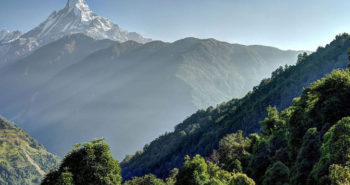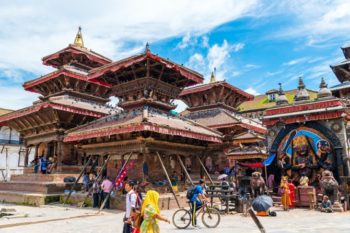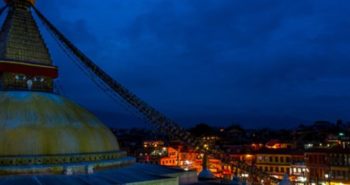Annapurna Circuit Trek Weather
The interesting thing about the Annapurna Circuit Trek is that you start at a very low altitude – 1000m/ 3,280ft at Nagadi on Day 1 of the trek. Over the next 4 or 5 days, you remain at a relatively low altitude before ascending to the eventual height of 5,416m/ 17,764ft going over the Thorong La pass.
Then you enter into more temperate areas, depending on where you are ending your trek. So obviously what you wear, what you need in way of gear, and what weather you can expect is going to vary widely. And then it varies again depending on the time of year!
So here is a breakdown of weather through the year which we think will guide you.
Spring – March, April, May
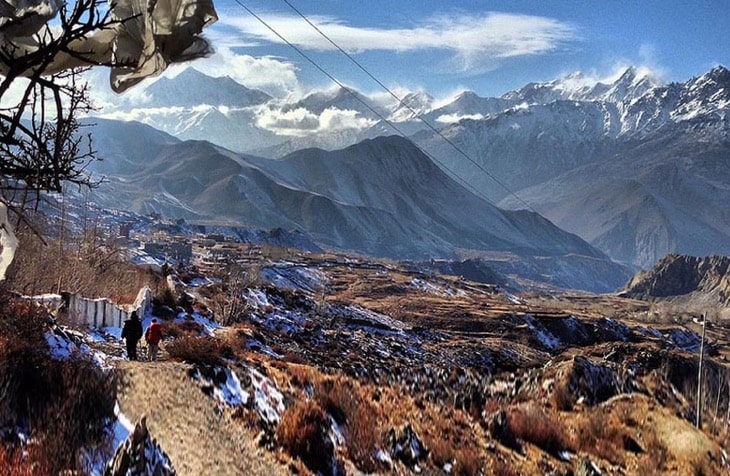
This is the most popular time of the year for trekking throughout the whole of Nepal. The skies will be clear and the days sunny. There will be no rain. At lower altitudes, it will be quite warm (maybe as much as mid-20s Celsius) yet as you ascend beyond 3,000m the days, although still sunny and comfortable, will be noticeably cooler.
Early mornings, evenings, and nights will require extra clothing for the chill! The average temperatures will be 7 to 24oC. At the high altitudes such as at Manang, Thorong Phedi, and going across the Thorong La Pass can be below freezing. There should be no snowfall or snow, or only remaining snow, on the Thorong La at this time of year.
If you are trekking on beyond Muktinath, be aware there are high winds in this area, and down as far as Marpha. The wind will howl across the mountains, down through the Kali Gandaki Gorge, the deepest gorge in the world. Walking in the morning rather than the afternoon when the winds get up, will reduce your battle against the wind.
What are the best things about the spring season?
The perfect weather and the lush vegetation! At lower altitudes, you will be passing through terraced farmlands and forests. The rhododendrons will be in bloom along with other colorful wildflowers.
Do I have to prepare for the cold?
This season is not considered as ‘cold’ in the Himalayas! A warm jacket (like a fleece) will be required in the morning and evening at the higher altitudes. During the day a T-shirt or shirt is enough.
Obviously crossing the high Thorong La pass will be cold (with temperatures as low as freezing) so extra layers will be required.
Is there any place to chill out and relax during the trek?
You will have an acclimatization day in Manang so you can explore the local Buddhist culture and once you cross the Thorong La there are interesting places such as the Bob Marley Hotel in Muktinath to explore.
But basically, as on any trek in Nepal, the lodge dining room with its warm fire is the center of nightlife! At the end of the trek – should you decide to go to Pokhara with its vibrant nightlight and laid-back lakeside bars and restaurants, you can enjoy it there. Or party equally as much back in Kathmandu!
How crowded will the trail be?
This is a peak trekking season in Nepal so the trails will be busy. This brings us back to the nightlife around the fire! Interesting conversations with fellow trekkers.
Summer/ Monsoon – June, July, August
With temperatures roughly the same as the spring it might even be a little less chilly. At lower altitudes, you may get rain, in which case the temperatures will drop.
As the upper sections of this trek (upper Manang) lie in the rain shadow there will be no rain here. These high-altitude areas will also be less cold than at other times and there is no snowfall (normally).
What can I expect during the monsoon season?
At lower altitudes, you can expect to leeches and rain. It doesn’t rain 24 hours a day but if you are not prepared even one hour of rain can make you miserable if you have wet feet! At the upper part of the Annapurna Circuit Trek, there will be no rain in the monsoon as it is in the rain shadow.
If you are heading down to Pokhara, be aware Pokhara sees more rain than Kathmandu in the monsoon. But on the plus side, expect far fewer tourists on the trails!
Is there anywhere to check the weather before trekking?
Yes, you can check the weather forecast. This is not very reliable as things change very quickly in the mountains.
Will there be landslides on this trail?
At the beginning of the trek, (coming from Besisahar) the road has been recently black-topped and stones put in place to mitigate flooding.
But there is still the possibility of landslides if there is very heavy rain. In the upper parts of the trek, there will be no rain-induced landslides.
Once you cross the Thorong La and if you are continuing down the main Annapurna trek to Pokhara there are possibilities of landslides or river overflow on the way.
Do you recommend trekking alone in this season?
We recommend you never trek alone in the Nepal Himalayas. But we recognize people do this. However, during the monsoon, there will be fewer people on the trails so we strongly advise you not to trek alone. We recommend you find a trekking partner or go through a trekking company during this season.
Is it safe to trek with children in the monsoon?
If you are doing the Annapurna Circuit Trek with children, the monsoon should not be a problem. Be aware there may be delays in case there are landslides and the lower trails may be slippery.
Perhaps it is not the best time for very young children, but older children should be okay at this time of year. Keep in mind the high altitude of the Thorong La pass when considering bringing children on this trek.
Autumn – September, October, November
Temperatures are similar to spring, getting cooler as the season gets later. But expect in the region of 10 to 24oC at lower altitudes with temperatures reaching freezing at the high altitudes.
Like the spring the weather is temperate and clear. There may be some leftover rain in September at the lower altitudes. November will see crystal clear skies! This is the other most popular time to trek – for obvious reasons!
What is so special about this season?
It is festival time! The two main Nepali festivals are held in October/ November. (Timings change each year so check the Nepali calendar). The weather is spectacular! The mountains are clear!
Any recommendation for this season?
Book in advance. As it is extremely busy, you should book as far in advance as you can. Also, many trekking staff, guides, etc will be taking holidays to celebrate the festivals with their family.
Be aware also that if you are trekking on beyond Muktinath, there are high winds in this area, down as far as Marpha. The wind will howl across the mountains, down through the Kali Gandaki Gorge, the deepest gorge in the world.
See Also,
Winter – December, January, February
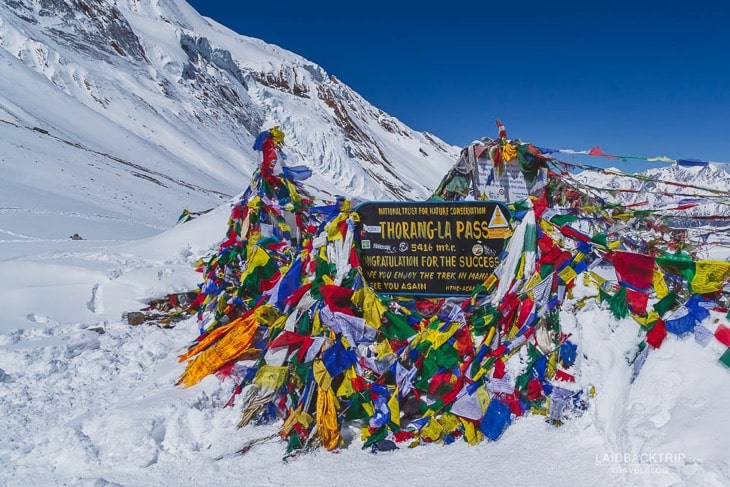
You can imagine what winter will be like in the Himalayas. There will be heavy snowfall at higher altitudes and the Thorong La pass at 5,416m will be hard to cross.
There may be some times when the pass is closed because of snow. In which case you will have to return the same way. If you have already winter trekking experience and are well prepared with the right, waterproof, gear you might enjoy the crisp air and empty trails of winter.
Views will be wonderful although you might be unlucky and have some cloudy days. It will be below freezing point at night at higher altitudes. Teahouses will remain open and that fire in the dining area is very welcoming!
I don’t mind cold. Can I trek in the winter?
Yes, you can! Just be prepared for the cold, and the wet snow underfoot. Bring your sense of adventure.
If you need more information on this trek or any other trek, please get in touch with us here at Magical Nepal.
FAQ:
What is the best time to trek?
March to May and September to mid-December is the best time to do the Annapurna Circuit Trek. It is also possible to do the Annapurna Circuit Trek in the monsoon as it is in the rain shadow.
What can I expect during the monsoon season?
Expect some rain at lower altitudes along with leeches and freshly washed scenery! At higher altitudes, there will be no rainfall as it is in the rain shadow.
I don’t mind cold. Can I trek in the winter?
Yes, if you don’t mind cold and snow you can certainly do the Annapurna Circuit in winter. Keep in mind the Thorong La pass may be closed if there is too much snowfall.
